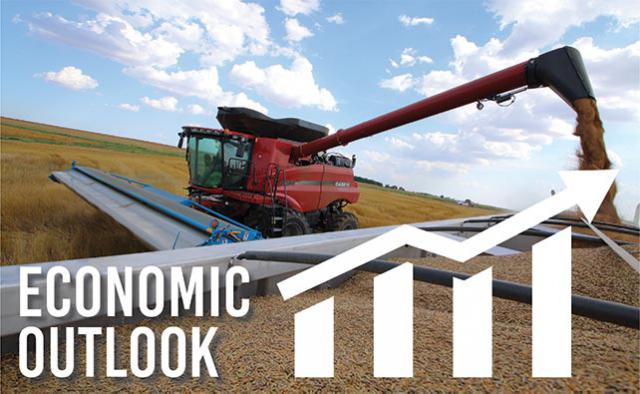
The keys for producers surviving 2017 have been a strong cattle market, increased grain and cotton production, and good demand.
| Your browser is not supported. While we have made efforts to ensure you can still browse the website, please consider upgrading to a more recent version of Internet Explorer, Firefox, or Chrome. | |
|
|

The keys for producers surviving 2017 have been a strong cattle market, increased grain and cotton production, and good demand.
Abundant production in 2017 coupled with good demand has kept Oklahoma farmers and ranchers in the economic game. As we look ahead to 2018, economic analysts expect more of the same economic fundamentals with hints of optimistic gains.
“It (the economy) looks better for 2018,” said Cortney Cowley, economist for the Federal Reserve Bank of Kansas City, Omaha branch. Cowley was the featured presenter at the recent OSU Rural and Economic Outlook Conference.
Any economic forecast is partially based on past experience. In this case, Cowley noted, in 2017 producers became accustomed to lower grain prices but were able to pay the bills due to increased production.
“The keys for producers surviving 2017 have been a strong cattle market, increased grain and cotton production, and good demand,” Cowley said.
“I think 2018 may still be a struggle but looks better than where we have been in the past several years,” Cowley said.
A similar prediction was issued by Pat Westoff, director of the Food and Agricultural Policy Research Institute at the University of Missouri.
“We’re looking at a slight uptick in farm income for 2018 but considerably lower than the 2010-2014 period,” Westoff said. “Relatively low crop prices will keep incomes lower than we want.”
Optimists searching for nuggets of hope can use the statistic on farm loan payment delinquency rates. Cowley expects the rates to decrease in 2018.
“Farmland values have been holding steady and risk management strategies have helped keep this rate low,” Cowely said. “This goes along with the strategies agriculture lenders have incorporated in recent years, working with bankers on finances, restructuring loans and using secondary markets as risk mitigation tools.”
Jackson Takach believes the good news for farmers going into 2018 is the robust demand for agricultural commodities. Takach is director of economic and financial research for the Federal Agricultural Mortgage Corporation, more commonly known as Farmer Mac. Farmer Mac, which is a secondary market for agricultural real estate mortgage loans, was created by Congress nearly thirty years ago to provide agriculture and rural communities’ access to affordable credit.
“We’re behind the scenes, offering banks and other ag lenders access to flexible, low-cost financing so that they, in turn, can deliver better rates and longer terms to their farm and ranch customers,” Takach said.
Takach said the somewhat sluggish farm economy the past several years has not been because of lack of demand for agriculture goods.
“This is not a demand problem, but rather an issue of abundant supply,” Takach said. “If we can continue to keep trade talks open, work on NAFTA and build more trade relations with China, then it is very good news for 2018.”
The bad news? The Farmer Mac economist said commodity prices will remain stagnant.
“I don’t anticipate a huge upswing in commodity prices,” Takach said, “so we may have to wait another year for that demand to rebuild profitability in farming.”
Like most economists, Larry Sanders has two hands. The Oklahoma State University agricultural economics professor expects 2018 to be similar to 2017, with a few caveats.
“The economy will continue to strengthen in early 2018,” Sanders said. He expects unemployment to remain low with wages remaining stagnant. Inflation will continue to creep into the equation as the federal budget deficit and debt remain high.
However, big changes could result from tax reform legislation and trade negotiations.
“Lower tax rates do not necessarily improve economic growth,” Sanders said. “Net farm income will slowly recover, but backing out of trade agreements could damage farm income.”
Sanders said reduced regulations and proposed tax cuts could boost economic growth. Scientific economic research indicates this is uncertain.

If we can continue to keep trade talks open, work on NAFTA and build more trade relations with China, then it is very good news for 2018.

Lower tax rates do not necessarily improve economic growth. Net farm income will slowly recover, but backing out of trade agreements could damage farm income.
A key to making a profit in 2018 will be producing a quality product, said Kim Anderson, OSU agricultural economics professor and Extension economist.
“The odds are that Oklahoma farm income from grains will remain at relatively low levels and in some cases below survival levels,” Anderson said. “Oklahoma’s wheat production break-even price is about $4.75 per bushel. At this writing, wheat may be forward contracted for 2018 wheat harvest delivery for $3.70 per bushel.”
The OSU economist emphasizes the need to grow a quality grain product.
“If Oklahoma farmers produce wheat with protein above 12 percent and test weight above 59.5, the 2018 wheat harvest price is projected at $4.50. With $4.50 wheat prices, producers with above average production may be able to cover more than variable costs.
The producer is going to have to grow a quality product for both the domestic and export market. If they can do that, it should generate a profit.”
Analysts predict that 2018 wheat harvested acres will be less than 2017’s 2.9 million acres. Corn, soybean, and cotton acres are projected to increase. Anderson said current corn, soybean price levels and average production could provide positive farm income but may not be enough to sustain farm survival.
Anderson also expects cotton prices and average cotton production to provide adequate income with some caution.
“Given more favorable cotton returns, farmers are projected to increase cotton planted/harvested acres which will have the tendency to lower cotton returns,” Anderson said.
The veteran economist sedately added most analysts predict it will take two to three years to work through these relatively low income years.
“Some farms will not survive,” Anderson said.
Record beef production in 2018 will lead to steady or slightly lower cattle prices, according to Derrell Peel, OSU Extension livestock marketing specialist.
“Herd expansion in 2017 means that feeder cattle supplies will continue to increase in 2018, pushing more cattle through feedlots,” Peel said. “Cattle slaughter will increase year over year and carcass weights, which declined in 2017, will likely increase as well in 2018. These are expected to combine for a four to five percent year over year increase and push 2018 beef production to a new record high.”
The OSU livestock specialist expects strong domestic and international demand for U.S. beef to continue in 2018.
“Increased beef exports and decreased imports are projected in 2018 and are expected to offset roughly half of the increase in beef production, thereby limiting the increase in domestic beef supplies,” Peel said. “New beef export potential in China is expected to grow slowly in 2018 but could add additional export support if growth in that market accelerates faster than expected. Domestic beef demand is expected to remain strong baring any unexpected U.S. macroeconomic or global economic shocks.”
Like most economists, Peel is ambidextrous! Beef demand could also be knocked down a notch or two.
“Beef demand will face challenges in 2018,” Peel said. “With growing pork and poultry production resulting in record total meat supplies, and threats of disruptions to trade agreements, this could negatively impact meat trade. The potential for unexpected demand weakness is the major source of downside risk in cattle and beef markets.”
Peel expects a small decrease in cattle prices due primarily to moderated demand in 2018.
“Average annual cattle price decreases of four to eight percent are anticipated though price decreases could be sharper by the end of 2018,” Peel said. “Feed and other input prices are expected to remain favorable in 2018. Profit margins for cattle producers will likely be squeezed in 2018, though modest profitability prospects continue. However, the general downtrend in cattle prices and higher downside price risk means that risk management takes on additional importance for cattle producers in the coming year.”

Beef demand will face challenges in 2018 ... the potential for unexpected demand weakness is the major source of downside risk in cattle and beef markets.

The producer is going to have to grow a quality product for both the domestic and export market. If they can do that, it should generate a profit.